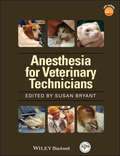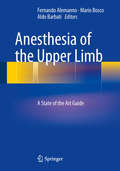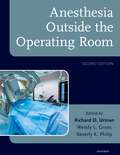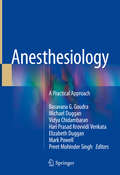- Table View
- List View
Anesthesia for the New Millennium: Modern Anesthetic Clinical Pharmacology (Developments in Critical Care Medicine and Anaesthesiology #34)
by Talmage D. Egan Theodore H.StanleyAnesthesia for the New Millenium: Modern Anesthetic Clinical Pharmacology contains the refresher course lectures of the 1999 meeting and is a review of the current state of the art in anesthesia clinical pharmacology. The authors of the individual chapters are among the world's most widely recognized experts in the pharmacology of perioperative medicine. The book features sections on new pharmacology concepts, new drug delivery techniques, recently released drugs and novel thinking about older drugs. It also addresses several areas that have recently emerged as very hot clinical and research topics, including depth of anesthesia monitoring technology and anesthesia drug interactions. The textbook is the seventeenth in a continuing series documenting the proceedings of the postgraduate course.
Anesthesia for Trauma: New Evidence and New Challenges
by Corey S. ScherTrauma is the leading cause of death among people under the age of 40 and it ranks third for all age groups. Still, relatively few clinicians specialize in trauma and training is often obtained through experience. The number of trauma patients is expected to continue to grow as pre-hospital care continues to advance. As well, hospitals increasingly see trauma treatment, which requires no pre-approval, as a good source of revenue. Given these developments, the number of opportunities for specialists trained in trauma, including anesthesiologists and critical care physicians, will expand in the years ahead. This book addresses the need for an up-to-date, comprehensive and clinically focused volume for practitioners and trainees in trauma anesthesia and critical care. It is organized by organ system. The editor is an attending physician at a major urban hospital center recognized worldwide for its outstanding emergency medical services including trauma care and is recruiting leading trauma anesthesiologists to contribute. Anesthesiologists, pain medicine physicians, critical care physicians and trainees are the target audience.
Anesthesia for Urologic Surgery
by Daniel M. Gainsburg Ethan O. Bryson Elizabeth A. M. FrostThis is a concise, up-to-date reference on anesthesia for urological surgery. Urological anesthesia is not recognized as a specialty, and a majority of anesthesiologists and nurse anesthetists will provide anesthesia for these patients. Advances in urological procedures, the advent of treatment of patients with strong anticoagulant and antiplatelet medications, and the demographics of urology patients (many of whom are young or elderly) present challenges for the anesthesiologist and have necessitated changes in anesthesia practice. The last volume on this topic was published in 2000, and the time is right for a fresh presentation of contemporary expertise in anesthesia for urological surgery.The book provides a brief review of renal physiology and pharmacology then addresses anesthesia for each major group of urological procedures (e.g., endoscopic, office-based, laparoscopic and robotic, nephrolithotripsy, renal transplantation, etc.) and in special populations, including the geriatric patient, the pediatric patient, and the pregnant patient. Separate chapters discuss the unique challenges of positioning the patient, and of managing the patient taking anticoagulant and antiplatelet medication, and the chapter on pain management addresses common and important perioperative concerns. The book provides a brief review of renal physiology and pharmacology then addresses anesthesia for each major group of urological procedures (e.g., endoscopic, office-based, laparoscopic and robotic, nephrolithotripsy, renal transplantation, etc.) and in special populations, including the geriatric patient, the pediatric patient, and the pregnant patient. Separate chapters discuss the unique challenges of positioning the patient, and of managing the patient taking anticoagulant and antiplatelet medication, and the chapter on pain management addresses common and important perioperative concerns.
Anesthesia for Veterinary Technicians
by Susan BryantAnesthesia for Veterinary Technicians is a highly practical guide to anesthesia skills for veterinary technicians published in association with the Academy of Veterinary Technician Anesthetists (AVTA). Packed with hints and tips to aid technicians in the practice of veterinary anesthesia, the book offers an essential resource to building anesthesia skills and improving knowledge. Encompassing both background knowledge and practical application of anesthesia-related skills, Anesthesia for Veterinary Technicians is a valuable resource for veterinary technicians of all skill levels. Supplementary website materials, including charts and forms for use in the practice, are available at www.wiley.com/go/bryant.
Anesthesia for Veterinary Technicians (Coursesmart Ser.)
by Susan Bryant Cvt VtsAnesthesia for Veterinary Technicians is a highly practical guide to anesthesia skills for veterinary technicians published in association with the Academy of Veterinary Technician Anesthetists (AVTA). Packed with hints and tips to aid technicians in the practice of veterinary anesthesia, the book offers an essential resource to building anesthesia skills and improving knowledge. Encompassing both background knowledge and practical application of anesthesia-related skills, Anesthesia for Veterinary Technicians is a valuable resource for veterinary technicians of all skill levels. Supplementary website materials, including charts and forms for use in the practice, are available at www.wiley.com/go/bryant.
Anesthesia, The Heart and the Vascular System: Annual Utah Postgraduate Course in Anesthesiology 1987 (Developments in Critical Care Medicine and Anaesthesiology #15)
by Bernard GeorgeTheodore H. Stanley. M. D. W. Clayton Petty. M. D. Anesthesia. the Heart and the Vascular System contains the Refresher Course manuscripts of the presentations of the 32nd Annual Postgraduate Course in Anesthesiology which took place at the Westin Hotel Utah Convention Center in Salt Lake City. Utah. February 20-24. 1987. The chapters reflect new data and concepts within the general framework of "risk. preoperative evaluation and monitoring. " "cerebral. pulmonary and peripheral vascular disease. " "new agents. their advantages and their problems" and "pediatric. cardiac and non-cardiac surgery. " The purposes of the textbook are to 1) act as a reference for the anesthesiologists attending the meeting. and 2) serve as a vehicle to bring many of the latest concepts in anesthesiology to others within a short time of the formal presentation. Each chapter is a brief but sharply focused glimpse of the interests in anesthesia expressed at the conference. This book and its chapters should not be considered complete treatises on the sub jects addressed but rather attempts to summarize the most salient points. This textbook is the fifth in a continuing series documenting the pro ceedings of the Postgraduate Course in Salt Lake City. We hope that this and the past and future volumes reflect the rapid and continuing evolution of anesthesiology in the late twentieth century. YO TABLE OF CONTENTS Diabetes: Preoperative Evaluation and Intraoperative Management Simon de Lange, M. D. , Ph. D.
Anesthesia in Day Care Surgery
by M. M. Begani Dheeraj V. Mulchandani Shagufta ChoudharyThis book features a collection of guidelines for anesthesia in day care surgery, covering all medical specialties that may look to venture into the ambulatory surgery domain. It provides various practical tips that can be used in day-to-day practice by anesthetists and surgeons alike, and covers various anesthetic protocols used by the stalwarts of the industry to illustrate the ideal techniques for anesthesia in day care surgery.
Anesthesia in High-Risk Patients
by Jean-Luc Fellahi Marc LeoneThis book describes the approach to anesthetic and perioperative management in different categories of high-risk patient scheduled to undergo elective noncardiac surgery. Individual sections focus on patients with conditions entailing cardiac and hemodynamic risks, respiratory risks, renal and metabolic risks, neurological risks, and other forms of risk. For each condition, up-to-date guidance is provided on risk evaluation, risk stratification, and intraoperative and postoperative anesthetic management. This is the first time that such different clinical situations have been gathered together in a single textbook of anesthesiology. All of the authors are international experts with extensive clinical experience. The aim is to provide trainee anesthesiologists with clear guidance that will prove invaluable when managing a wide range of patients with serious illnesses or conditions that pose a significant anesthetic risk. The book will also serve as a valuable reference for more experienced anesthesiologists and intensivists.
Anesthesia in Low-Resourced Settings: Near Misses and Lessons Learned
by John G. Brock-UtneThis book outlines the many anesthesia-related obstacles, concerns, and challenges that may be encountered by western trained anesthesiologist in low-resourced settings. Each chapter presents a challenging scenario with solutions. It is therefore an essential handbook that will prepare those performing anesthesia in this milieu. All case studies represent real accounts discussing equipment and drug constraints as well as the ethical questions that arise for western doctors working in this environment.Socially conscious and timely, Anesthesia in Low-Resourced Settings is an invaluable resource for medical practitioners who plan to work in these challenging settings.
Anesthesia in Thoracic Surgery: Changes of Paradigms
by Mert Şentürk Manuel Granell GilThis book reviews and describes the best practices of anesthesia in thoracic surgery, according to evidence-based medicine. It covers preoperative assessment, applied pharmacology, airway management and ventilation methods. The analgesic methods in this surgical specialty are also discussed. This book is aimed at all specialists in the world of anesthesiology and critical care as well as to physicians in training. It may also be of interest to thoracic surgeons and pulmonologists.
Anesthesia Informatics (Health Informatics)
by Jerry Stonemetz Keith RuskinThe ability to interface patient monitors directly to a computer, and generate a clinical record has existed for over 20 years. However, the acceptance of comprehensive electronic medical records in anesthesia has been slow to develop. Experts anticipate this reluctance is changing because of enhanced patient care through the use of detailed health information record systems. Anesthesia Informatics provides the health informatician and administrator with a comprehensive overview of this blossoming technology. With contributions from leaders in the field, this user-friendly guide addresses how this technology has enhanced both the need for and the ability to collect and apply data in an acute care setting. It also offers invaluable insight on the business implications and the rationales required to make a purchase decision. Each section outlines need to know information to help the reader with the implementation and utilization of an Anesthesia Information Management System. Useful case scenarios focus on the ideal components (anesthesia record, business rationale, communication, collaboration, and training) of a fully automated record-keeping system.
Anesthesia Management for Electroconvulsive Therapy: Practical Techniques and Physiological Background
by Shigeru SaitoIn this book, recognized anesthesiology experts present the latest findings on anesthesia for electro-convulsive therapy (ECT). With the development of modified electroconvulsive therapy (m-ECT) and devices to provide brief-pulse stimulation, ECT is currently being re-evaluated as an important procedure in psychiatric disorder therapy and is increasingly being used worldwide to treat several psychiatric conditions. This trend is due to the social phenomenon of the growing number of patients for whom ECT is applicable. Since the new approach is more safe and effective than the original method without anesthesia, m-ECT is currently applied under general anesthesia in most advanced countries. This book provides an overview and practice of total anesthesia management in the perioperative period of ECT. It offers an indispensable resource not only for professional anesthesiologists but also healthcare professionals who use this therapy.
Anesthesia of the Upper Limb: A State of the Art Guide
by Fernando Alemanno Mario Bosco Aldo BarbatiLoco-regional anesthesia offers evident advantages in almost all branches of surgery since it couples perfect anesthesia with prolonged postoperative analgesia. Furthermore, new drugs and techniques are ensuring constant progress, and in the past decade the advent of ultrasound-guided regional anesthesia has played a key role by allowing direct visualization of all anatomic structures involved in regional blocks. In conjunction with electrostimulation, it has significantly increased the success rate of loco-regional anesthesia.This book, comprising 16 chapters and more than 140 color illustrations, provides detailed coverage of the techniques currently employed in upper limb anesthesia. It opens by reviewing the anatomy of the brachial plexus and the topographic anatomy as it is of the utmost importance for anesthesiologists to have a deep knowledge of anatomy despite the assistance offered by new tools. Subsequently the various techniques, including supraclavicular, infraclavicular, and axillary brachial plexus blocks, peripheral blocks, and intravenous regional anesthesia, are discussed in depth, with due attention to potential complications. Up-to-date information is also provided on the role of ultrasound, and an entire chapter is devoted to ultrasound-guided interscalene and supraclavicular blocks. The book will be an invaluable learning tool for students and an excellent aid in daily clinical practice for anesthesiologists.
Anesthesia Outside the Operating Room
by Richard D. Urman, Wendy L. Gross and Beverly K. PhilipAnesthesia Outside of the Operating Room is a comprehensive, up-to-date textbook that covers all aspects of anesthesia care in OOR settings, from financial considerations to anesthetic techniques to quality assurance. With increasing numbers of procedures such as cardiac catheterization and imaging taking place outside of the main OR, anesthesia providers as well as non-anesthesia members of the patient care team will find this book critical to their understanding of the principles of anesthesia care in unique settings which may have limited physical resources. The book includes chapters on patient monitoring techniques, pre-procedure evaluation and post-procedure care, and procedural sedation performed by non-anesthesia providers. Its authors address problems of anesthesia that have unique answers in OOR settings, such as patient transport and cardiac arrest, and discuss technological progress and considerations for the future. The text also covers surgical procedures and anesthetic considerations by procedure location, such as radiology, infertility clinics, field and military environments, and pediatric settings, among many others Select guidelines from the American Society of Anesthesiologists (ASA) are provided as well. Edited by the senior faculty from Harvard Medical School and with contributions from other academic institutions, Anesthesia Outside of the Operating Room provides a unique and convenient compendium of expertise and experience.
Anesthesia Outside the Operating Room
Anesthesia Outside of the Operating Room is a comprehensive, up-to-date textbook that covers all aspects of anesthesia care in OOR settings, from financial considerations to anesthetic techniques to quality assurance. With increasing numbers of procedures such as cardiac catheterization and imaging taking place outside of the main OR, anesthesia providers as well as non-anesthesia members of the patient care team will find this book critical to their understanding of the principles of anesthesia care in unique settings which may have limited physical resources. The book includes chapters on patient monitoring techniques, pre-procedure evaluation and post-procedure care, and procedural sedation performed by non-anesthesia providers. Its authors address problems of anesthesia that have unique answers in OOR settings, such as patient transport and cardiac arrest, and discuss technological progress and considerations for the future. The text also covers surgical procedures and anesthetic considerations by procedure location, such as radiology, infertility clinics, field and military environments, and pediatric settings, among many others Select guidelines from the American Society of Anesthesiologists (ASA) are provided as well. Edited by the senior faculty from Harvard Medical School and with contributions from other academic institutions, Anesthesia Outside of the Operating Room provides a unique and convenient compendium of expertise and experience.
Anesthesia, Pain, Intensive Care and Emergency Medicine — A.P.I.C.E.: Proceeding of the 14th Postgraduate Course in Critical Care Medicine Trieste, Italy — November 16–19, 1999
by A. GulloThe end of the second millenium is distinguished for the increasing interest in the field of critical care medicine, not only among physicians and clinical scientists but also on the part of the mass media. This is an interdisciplinary area of medicine drawing upon the specialties of anesthesiology, internal medicine and surgery, and relying upon the essential contributions and support from basic research. Advances in critical care medicine depend on the application of new technologies to the clinic, the full integration of computers and informatics, the continual training of physicians and technicians, and the consideration of ethical issues in the clinical setting. Within this complex panorama of complementary approaches and viewpoints, it is apparent that critical care medicine is one of the best examples of evidence-based medicine.
Anesthesia Secrets E-Book (Secrets)
by James DukeAnesthesia Secrets, 4th Edition by James Duke, MD has the quick answers you need for practice and review. It uses the popular question-and-answer format of the Secrets Series® to make essential guidance easy to reference and study. A list of the Top 100 Secrets in anesthesiology lets you review the most frequently encountered board review questions at a glance; and an informal tone, user-friendly format, and pocket size make the book both convenient and portable. A section on the Top 100 Secrets in anesthesiology provides you with a high-yield overview of essential material for study or self assessment. A question-and-answer format, Key Points boxes, bulleted lists, mnemonics, and a two-color page layout make information remarkably easy to reference and review. Practical tips from the authors provide valuable insights into best practices. The book's portable size lets you carry it comfortably in your lab coat pocket. Thorough updates throughout equip you with the most up-to-date information on all areas of anesthesia, including the most current standards of care.
Anesthesia Secrets E-Book: Anesthesia Secrets E-Book (Secrets)
by Brian M. Keech Ryan D. LaterzaFor more than 30 years, the highly regarded Secrets Series® has provided students and practitioners in all areas of health care with concise, focused, and engaging resources for quick reference and exam review. Anesthesia Secrets, 6th Edition offers practical, up-to-date coverage of the full range of essential topics in the practice of anesthesiology. This bestselling resource features the Secrets' popular question-and-answer format that also includes lists, tables, pearls, memory aids, and an easy-to-read style – making inquiry, reference, and review quick, easy, and enjoyable. - The proven Secrets Series® format gives you the most return for your time – succinct, easy to read, engaging, and highly effective. - Fully revised and updated throughout, including protocols and guidelines that are continuously evolving and that increasingly dictate best practices. - New chapters on Electrocardiogram Interpretation, Cardiac Physiology, Vasoactive Agents, Volume Assessment, Blood Pressure Disturbances, Mechanical Ventilation Strategies, Perioperative Point-of-Care Ultrasound and Echocardiography, Neuraxial Techniques, Peripheral Nerve and Trunk Blocks, Patient Safety, and Medical Ethics. - Top 100 Secrets and Key Points boxes provide a fast overview of the secrets you must know for success in practice and on exams. - Features bulleted lists, mnemonics, practical tips from leaders in the field – all providing a concise overview of important board-relevant content. - Portable size makes it easy to carry with you for quick reference or review anywhere, anytime.
Anesthesia STAT! Acute Pediatric Emergencies in PACU: A Clinical Casebook
by Susan T. VergheseThis case-based book comprehensively covers the clinically significant problems that can occur in children in the immediate postoperative period after surgery after admission to Post Anesthesia Care Unit. Chapter authors first focus on how clinical monitoring and safety of post-op patients can and must continue after hand off to the PACU team and then describe 24 interesting clinical scenarios that needed urgent intervention in PACU. The goal of this book is to teach members of the perioperative teams around the globe how to keep anesthesia stat calls to a minimum. Anesthesia STAT! Acute Pediatric Emergencies in PACU features contributions from leaders in pediatric anesthesiology and be an indispensable guide for the perioperative and postoperative team in preventing potential problems during the post-anesthetic period.
Anesthesia Student Survival Guide: A Case-Based Approach
by Jesse M. Ehrenfeld Richard D. Urman B. Scott SegalThis comprehensive update of the previous two successful editions covers both basic and advanced anesthesia topics. These include pharmacology, procedures, monitoring, equipment, subspecialty anesthesia, safety, professionalism, pain management, and more.Chapters are concise, easy-to-read, and authored by faculty specialized in medical education. They feature case studies designed to help apply theoretical knowledge to real patient situations, as well as questions and answers. A convenient resource for medical students, student registered nurse anesthetists, and student anesthesiologist assistants in any student of anesthesia will find this unique book useful.
Anesthesia Student Survival Guide: A Case-Based Approach (Lecture Notes In Biomathematics #Vol. 30)
by Jesse M. Ehrenfeld Richard D. Urman Scott SegalEdited and written by leading educators, this popular book for the anesthesiology rotation has been thoroughly updated and retains its distinctive case-based approach. The Second Edition features a thorough revision of the discussion of ventilator management, improved coverage of extubation criteria, and the latest guidelines and algorithms for preoperative assessment. Considerations for quality improvement and patient safety have been expanded throughout the book. Anesthesia Student Survival Guide provides a complete introduction to the specialty and is aimed at medical and nursing students as well as practitioners in critical care who seek a succinct overview of anesthesiology. From reviews of the First Edition: “…an excellent resource for the student wanting a deeper understanding of what is essentially a post-graduate subject, for example, an elective student.” --British Journal of Anaesthesia “This is an excellent introduction to the specialty for third-year medical students, covering a broad range of material at a sufficient depth to be useful, and providing a good structure for a comprehensive course of self-directed study.” --Doody’s Review Service “The writing style is uniformly strong, which makes the book easy to read.…[It] serves not only as an excellent resource for students and other learners seeking an introduction to anesthesia but also as a platform for teaching the basics. It will be a welcome addition to the libraries of teaching departments.” --Canadian Journal of Anesthesia
Anesthesia Student Survival Guide: A Case-Based Approach (Lecture Notes In Biomathematics #Vol. 30)
by Richard D. Urman Scott Segal Jesse M. EhrenfeldAnesthesia Student Survival Guide: A Case-Based Approach is an indispensable introduction to the specialty. This concise, easy-to-read, affordable handbook is ideal for medical students, nursing students, and others during the anesthesia rotation. Written in a structured prose format and supplemented with many diagrams, tables, and algorithms, this pocket-sized guide contains essential material covered on the USMLE II-III and other licensing exams. The editors, who are academic faculty at Harvard Medical School, summarize the essential content with 32 informative and compelling case studies designed to help students apply new concepts to real situations. Pharmacology, basic skills, common procedures and anesthesia subspecialties are covered, too, with just the right amount of detail for an introductory text. The unique book also offers a section containing career advice and insider tips on how to receive good evaluations from supervising physicians. With its combination of astute clinical instruction, basic science explanation, and practical tips from physicians that have been there before, this handbook is your one-stop guide to a successful anesthesia rotation.
Anesthesiology: Clinical Case Reviews
by Linda S. Aglio Richard D. UrmanDivided into twelve sections that cover the entirety of anesthetic practice, this is a case-based, comprehensive review of anesthesiology that covers the basics of anesthetic management and reflects all new guidelines and recently developed standards of care. Each chapter of Anesthesiology: Clinical Case Reviews begins with a specific clinical problem or a clinical case scenario, followed by concise discussions of preoperative assessment, intraoperative management, and postoperative pain management. In addition to residents and fellows, this book is written for practicing anesthesiologists, student nurse anesthetists, and certified registered nurse anesthetists (CRNAs).
Anesthesiology: A Practical Approach
by Basavana G. Goudra Michael Duggan Vidya Chidambaran Hari Prasad Venkata Elizabeth Duggan Mark Powell Preet Mohinder SinghThis book provides a practical approach to the anesthetic management of surgical and nonsurgical procedures across the spectrum of anesthesia sub-specialties. This book will assist the practitioner to plan their anesthetic from preoperative evaluation phase to complete recovery or transfer to another special care area. The emphasis is on both the planned technique and more importantly the logic or reasoning behind the suggested technique.This book addresses all important procedures in anesthesiology, including preoperative evaluation, airway management, and fluid administration. Every chapter discusses a specific surgery or procedure. Some topics of special interest are also included.Anesthesiology: A Practical Approach is aimed at anesthesia residents, anesthesia nurse practitioners, and experienced anesthesiologists called upon to work in any area or anesthetizing location.






















